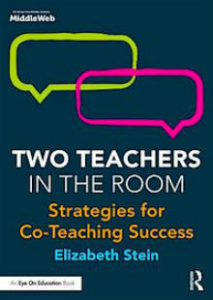Parents Can Be Virtual Co-Teaching Partners
A MiddleWeb Blog
 Did you ever stop to really think about parents as your co-teaching partners? It’s far from a new idea. See this Educational Leadership article from ASCD that dates back to March 2015 as an example.
Did you ever stop to really think about parents as your co-teaching partners? It’s far from a new idea. See this Educational Leadership article from ASCD that dates back to March 2015 as an example.
We are all living the reality of not just being “Two Teachers in the Room.” Rather, we are all teachers beyond the room— reaching into many rooms. The meaning of this reality is tremendously variant as we all experience the COVID-19 pandemic in very personal ways.
Since our physical classrooms have been replaced by remote learning platforms, the connection between students, parents, and teachers takes on a whole new life. Let’s take a few minutes to consider how we are making the most of expanding our co-teaching relationships through the disruption of building closures and the physical distancing due to COVID-19.
For starters, we know the basic needs and emotional well-being of our families (and ourselves) must be kept at the heart of how we experience each day. The Centers for Disease Control and Prevention remind us about staying current with the facts and seeking coping resources as needed.
Emotional well-being resources provided by Child Trend and Child Mind Institute offer opportunities to find the SEL balance needed before taking on the academic aspects of teaching and learning from home. For additional support see The Collaborative for Academic Social and Emotional Learning (CASEL) resources we can tap into as we empower ourselves to accept, manage, and thrive to the best of our abilities during these times.
Moving toward the academic spaces, let’s consider some ways we can deepen our co-teaching connection with parents.
Classroom Management
✻ Let’s make sure that our online learning spaces are accessible to our parents – and that we provide supports to make it as accessible as needed. This includes anything from our district providing laptops and information about wifi access, to using digital platforms and tools that support individual and collective needs. Check out these apps from Common Sense Education or these Google Tools.
✻ Keep tasks manageable with consistent routines (yes, we know this – but it is worth checking in with!).
✻ Consistent routines along with time to explore one’s interests is one way to guide and manage students’ learning behaviors in positive ways.
Engagement and Motivation
✻ Incorporate choice as a surefire way to engage and motivate students. Check out this link for specific thinking around how to engage through a Universal Design for Learning lens via CAST.

✻ Humanize the learning experience by creating plenty of opportunities for teachers to check in with parents and students in multiple ways including writing/texting, audio, and visual connections.
✻ And make learning strengths known through this quick activity – then see how students apply them with new confidence during future learning tasks.
Instructional Delivery and Progress Monitoring
✻ Continue to embed IEP goals within the general education curriculum. We know supports that are necessary for some are good for all. We also know that some supports are best done in small groups or individually.
✻ Create opportunities for self-regulation. Empower students to be strong co-teaching partners as well as they take charge of their learning with the guidance of teachers and parents.
✻ Incorporate formative assessments to broaden students’ progress beyond test scores and grading. Provide rubrics when applicable, guide parents with scripts for providing specific feedback based on the feedback you provide, remind parents to notice students’ attention to task and use of strategies to guide their personal progress. Small celebrations can create monumental progress in the long run.
This post is just the beginning of meaningful discussions for how to welcome parents as co-teaching partners. How are you experiencing this newly strengthened co-teaching bond with your parents? How are you embracing this time where two teachers in the room is now many teachers across many rooms – connected digitally, yes, but also by the human traits of compassion and empathy that keep us all teaching and learning and staying well and strong.
Let’s keep the conversation going! Leave a comment here and also tag me @ElizabethLStein and use the hashtag #coteachat on Twitter to widen our perspectives and action steps.




































